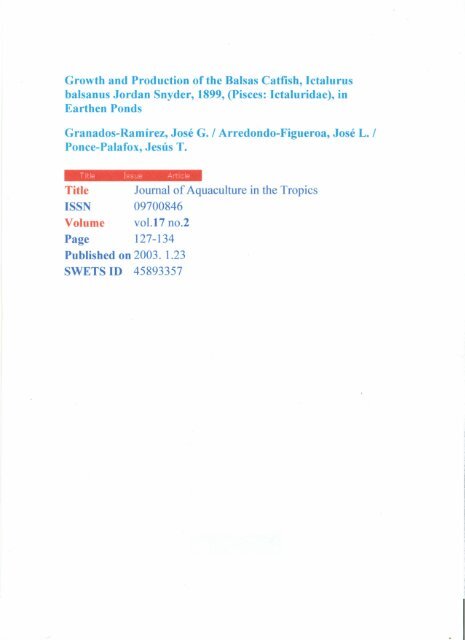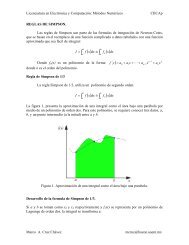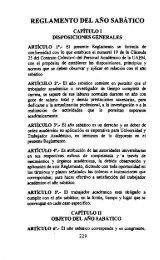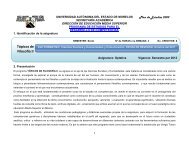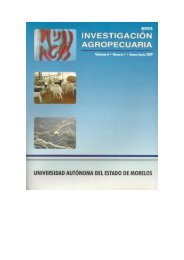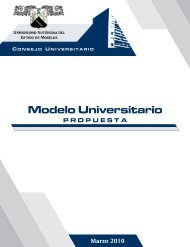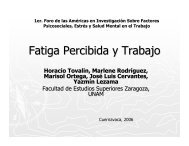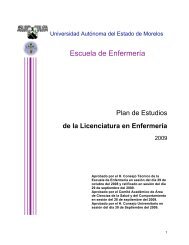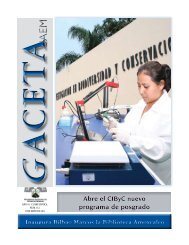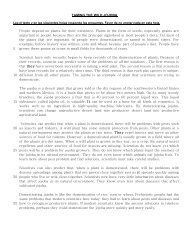Growth and Production of the Balsas Catfish, Ictalurus ... - UAEM
Growth and Production of the Balsas Catfish, Ictalurus ... - UAEM
Growth and Production of the Balsas Catfish, Ictalurus ... - UAEM
You also want an ePaper? Increase the reach of your titles
YUMPU automatically turns print PDFs into web optimized ePapers that Google loves.
<strong>Growth</strong> <strong>and</strong> <strong>Production</strong> <strong>of</strong> <strong>the</strong> <strong>Balsas</strong> <strong>Catfish</strong>, <strong>Ictalurus</strong><br />
balsanus Jordan Snyder, 1899, (Pisces: Ictaluridae), in<br />
Ear<strong>the</strong>n Ponds<br />
Granados-Ramírez, José G. / Arredondo-Figueroa, José L./<br />
Ponce-Palafox, Jesús T.<br />
Title I::.::ue ~r,i.:::e<br />
Title Joumal <strong>of</strong> Aquaculture in <strong>the</strong> Tropics<br />
ISSN 09700846<br />
Volume vol.17 no.2<br />
Page 127-134<br />
Published on 2003. 1.23<br />
SWETS ID 45893357
GROWTH ANO PRODUCTION OF THE BALSAS<br />
CATFISH, ICTALURUS BALSANUS JORDAN &<br />
SNYDER, 1899, (PISCES: ICTALURIDAE), IN<br />
EARTHEN PONDS<br />
JOSE G. GRAtiADOS-RAMIREl, 1 JOSE L. ARREDONDO-<br />
FIGUEROA 2 ena JESUS T. PONCE-PALAFOX 3<br />
1FaaJIlad de Ciencias aioIóQiras Uriversidad AlJiónoma del Estado de Morelos. Méx/w.<br />
PO. Box 584 Cuemav-aec. l.IoreIos. Méxia:J 62001.<br />
lPlanta Experimenta! de ProciJccióo Act.Ji
.;~j<br />
liz~<br />
.:o.<br />
•.•••
Jooma1 01Aquaculture in <strong>the</strong> Tropics May 2002 129<br />
dissolved oxygen (YSI 57 oxygen meter), pH (Coming M·106 pH meter),<br />
conduclivity (Conductivimeter YSI 33), Secchi visibility <strong>and</strong> total dissolved<br />
solids were measured once a month according to Boyd (1996). Daily<br />
water exchange was adjusted to maintain Secchi visibility above 30 cm<br />
<strong>and</strong> measured with a meter in <strong>the</strong> experimental pond. Water quality data<br />
representa only lhe surface water.<br />
Fish were fed at 6% <strong>of</strong> lheir metabolic weightlday with catfish cornmercial<br />
food (Silver cup), made in Mexico by El Pedregal Foods Cornpany<br />
(38% protein, 21.4% lipid, 20.95% carbohydrate, 1.84% fibre, 11.58%<br />
ash contenl in a pellet size ot 9.3 mm). Quantity 01 rooc was readjusted'<br />
every 2 weeks based on a growth rate estimáte. Cat1ishwere fed 6 days<br />
a week, dürin~ <strong>the</strong> moming (0.8:00 h) <strong>and</strong> <strong>the</strong> evening (18:00 h).<br />
The w = aL lunction was used to obiain <strong>the</strong> weight <strong>and</strong> length retatíonship<br />
(Wea<strong>the</strong>rley I 1972). Physico-chemical data, total lenglh <strong>and</strong> total<br />
tresh weight were submitted to statistical descriptive <strong>and</strong> Box plot statistical<br />
analysis using <strong>the</strong> STATISTICA version 5.0 package (1997).<br />
RESULTS<br />
Water temperature, dissolved oxygen, pH, totai dissolved solids <strong>and</strong> conductivity<br />
parameters were measured frcm March 1994 lb February 1995<br />
(Fig. 1). The data indicates that, during this period pH values ranged<br />
between 7.6 to 9.0; dissolvad oxygen 4.3 to 5.8 mgll; total dissolved<br />
solids 476 to 600 mgil, <strong>and</strong> conductivity from 560 to 800 umbos/cm. The<br />
water temperature <strong>and</strong> pH were <strong>the</strong> most stable parameters alon9 <strong>the</strong><br />
growth periodo Total dissolved solid <strong>and</strong>conductivity showed seasonal<br />
fluctuations in relation to <strong>the</strong> availability ot water source. The concentralions<br />
<strong>of</strong> <strong>the</strong>se parameters were reduced towards <strong>the</strong> end <strong>of</strong> year (October<br />
to December); <strong>the</strong> dissolved oxygen on <strong>the</strong> o<strong>the</strong>r h<strong>and</strong> showed an increased<br />
tendency trorn June until <strong>the</strong> end ot <strong>the</strong> experiment. The method<br />
for rearing <strong>the</strong> species has been developed in warm-water pond farms,<br />
in <strong>the</strong> sou<strong>the</strong>m part <strong>of</strong> Mexico, where a long (280 to 320 days) <strong>and</strong> warm<br />
(25 to 35·C) season contributes to <strong>the</strong>ir rapid growth. With respect to<br />
<strong>the</strong>se abiotic tactors; water quality appeared to be favourable for ñsh<br />
production.<br />
<strong>Growth</strong> <strong>and</strong> production estimates are shown in Table 1. The highest<br />
growth rate were observed from June to January (Fig. 2) at water<br />
temperatures above 30·C. Total weight gain per fish in a twelve-month<br />
period was <strong>of</strong> 390 g. The results iIIustrate <strong>the</strong> advantages ot raising <strong>the</strong><br />
species in warm-water tish farms throughout <strong>the</strong> year, since as good<br />
growth-rates were even recorded during <strong>the</strong> winter. The maximum growth<br />
for <strong>the</strong> smallest fish took place at 29 to 3S·C, whereas <strong>the</strong> biggest fish<br />
grew best at 28 to 30·C. Specific growth rate decreased from a maximum<br />
1<br />
~
__ ·..:J!WIlU ::~. .." .. :~,':' .. .·:'iI¡!9l!<br />
(5 CI)<br />
CI)<br />
e<br />
40 r-<br />
o°e 30 ¡..... Ií'<br />
~ I<br />
E 20 1<br />
CI.I •<br />
C. .<br />
~ 10 ~ I<br />
o .t-.<br />
700<br />
600 .<br />
500<br />
400<br />
'._300<br />
(<br />
~···----T-·- 'ro '1"-'"<br />
7<br />
i<br />
~ 6<br />
§. 5<br />
c:<br />
I<br />
I ~ 4<br />
~<br />
I o 3<br />
I<br />
I<br />
-e<br />
41<br />
I ><br />
_ ..... _- --- 1000<br />
200 1 1<br />
100 I<br />
o M A M J J A' 5 o N o E F'<br />
I<br />
'O In<br />
IIJ<br />
C3<br />
2<br />
o<br />
-<br />
l.' 5<br />
> CI)<br />
.- o<br />
Ü.r.<br />
::J E<br />
~<br />
c:<br />
o<br />
lo.<br />
o u<br />
l> .- E-<br />
.- -<br />
~<br />
800<br />
600<br />
400<br />
I<br />
." . ",<br />
~ 1<br />
200 1\<br />
o L--.__~~~~ __ ~~ ~<br />
MAMJ JASONDFF<br />
Ag. 1: Water temperature. total dlst.olved soRd <strong>and</strong> conductlvlty values 01 tho pond water. The vaíues glveo are data comblned 1rom Ihree<br />
. repllcat,,!'.<br />
r<br />
tII<br />
g<br />
g<br />
~ 5l.<br />
).<br />
1 ••<br />
!5'<br />
S<br />
CI><br />
f E<br />
-cN<br />
8:-.l
'. -<br />
'.~;....<br />
j<br />
: :<br />
Jouma1 01Aquacvtture ~ th6 trcocs May 2002 131 ,<br />
Table 1. GrowU1 <strong>and</strong> Pfodt..Ctioo estimales ter lhe <strong>Balsas</strong> catíisri cunere in .arltlen<br />
poods during • xpe rimenl<br />
Parametsrs Dala<br />
a) 8
.)<br />
,<br />
'¡<br />
•.•.,,;<br />
~<br />
.. M A M J<br />
'.<br />
~<br />
i<br />
¡<br />
.¡<br />
~ .:'0<br />
:::.<br />
';.:<br />
.;..<br />
.',<br />
~.~:<br />
"'!'<br />
~<br />
?~<br />
?J<br />
;~<br />
132 Joumal 01!.quacu/l¡;re", :11e Troocs May 2002 ,<br />
Month<br />
ASONOE z<br />
700 I ¡<br />
600<br />
500<br />
§0)<br />
E 01<br />
-¡j<br />
- S 300<br />
.(:",<br />
200<br />
100<br />
O<br />
300<br />
250 1<br />
Ci 200<br />
cw~J<br />
33 66· 99 132 165 198 231 264 297 3JO ;;5<br />
rme(~ys)<br />
F.g. 2: Average weighls olltle <strong>Balsas</strong> catrlSh in ear<strong>the</strong>n ponds.<br />
y = O.0262x2" 0l<br />
R 2 = 0.9768<br />
-s:<br />
«:» 150'<br />
-(U I • •<br />
~1oo<br />
50<br />
O<br />
•<br />
-r-<br />
'"<br />
:r: Ihl-Max<br />
O 25'1.-75'1.<br />
O ~j¡n y&JJe<br />
O 5 10 15 20 25 30<br />
Length (cm)<br />
F9. 3: Weight-lenglh relationship <strong>of</strong> <strong>the</strong> <strong>Balsas</strong>catf"¡shunder culture conártions.<br />
)
Jouma1 o( Aqucicuture ., th6 TfOP'CS Ma Y 2002 133<br />
DISCUSSION<br />
The growth season at Jicarero Farm is related to water temperature <strong>and</strong><br />
goes from <strong>the</strong> beginning 01 June lo <strong>the</strong> end 01 November. PotentiaJ<br />
productioo appears most lavourable towards <strong>the</strong> summer season. The<br />
<strong>Balsas</strong> catfish is considered <strong>the</strong> mosl promising native lish tor culture in<br />
ponds <strong>of</strong> central <strong>and</strong> sou<strong>the</strong>rn Mexico inl<strong>and</strong> waters, basically because<br />
<strong>the</strong>y can adapt ver)' well to environment changes such as water temperature.<br />
Guthrie <strong>and</strong> Avauit (~968; 1969), indicated that l. punctatus with an \¡<br />
inñial weigh! <strong>of</strong> 18 g, in 10 months time can reach 589 g under cultura<br />
conditioos: also, l. furcatus with an average weighl <strong>of</strong> 13.6 9 in <strong>the</strong> same<br />
period <strong>of</strong> time in creases upto 272.5 9 <strong>and</strong> l. eatus wilh aro initia! mean<br />
weighl <strong>of</strong> 18 9 in 9 months reaches 317.5 9 <strong>of</strong> average weight. Channel<br />
catfish under semi-intensive culture cooditions can reach ir. 12 lo 18<br />
monlhs a commercial weight <strong>of</strong> 450 9 (Bardach et al., 1972). Our data<br />
shows that unoer ear<strong>the</strong>n poods cuíture conditions <strong>the</strong> Baisas catfish can<br />
reacn similar wp.ights to those reached by l. punctatus, 1. furcatus aliá<br />
l. estos. The development <strong>of</strong> bitechniques on <strong>the</strong> reproduction oí fish<br />
species in fish farms <strong>and</strong> ponds had elucidated <strong>the</strong> essential biological<br />
characteristics for rearing Ihe specles on 2. commercial scale. <strong>Balsas</strong><br />
catfish raised in ponds consumed both natural <strong>and</strong> precared diets <strong>and</strong><br />
<strong>the</strong> spectrum <strong>of</strong> foods is found to be comparatively wider with. respect<br />
to o<strong>the</strong>r aquaculture species (Kato <strong>and</strong> Romo, 1981). Our investigations<br />
have shown that in pond farms, <strong>Balsas</strong> catñsh spawned successfully with<br />
<strong>and</strong> without administration ot hypophyseal injection. The results ot acclimatization<br />
ot <strong>Balsas</strong> catfish in Morelos, State. <strong>of</strong> Mexico has shown<br />
that it is very promising for aquaculturists. The overall conclusion <strong>of</strong> this<br />
study shoulé ')e that <strong>the</strong> growth <strong>of</strong> this species is indeed a highly variable<br />
characteristic. ConsequenUy, <strong>the</strong> reported values for <strong>the</strong> parameters used<br />
in various relations are representativa ooly for <strong>the</strong> condition prevailing in<br />
this experíment. <strong>Balsas</strong> catfish is a valuable species tor introduction to<br />
ponds in sou<strong>the</strong>m <strong>and</strong> central Mexico <strong>and</strong> tor rearing in fish farrn<br />
monoculture <strong>and</strong> polyculturé systems.<br />
ACKNOWLEDGEMENTS<br />
We would like to acknowledge A.L Martinez ·Solís who took part in <strong>the</strong><br />
experiment.<br />
\
::;<br />
--, ~.<br />
;:e<br />
~l<br />
.~,;<br />
,<br />
I~<br />
-•....• !<br />
....:..<br />
13-4 Jouma/ o( Aquacuture in tri« Troocs May 2002<br />
REFERENCES<br />
Bardach. J.E .. Rytner. J.H. <strong>and</strong> Mct..a.mey. W.O. (1972). Aquaculture: The farming <strong>and</strong><br />
husb<strong>and</strong>ry 01 Ireshwa1er Mld marine Ofl/anisms. Wiley·lnterscieoce. John waey & Sons.<br />
lnc, New YOÓ:.868 pp.<br />
Bok. A.H. <strong>and</strong> Jongbloed. H. (1984). GroW1tl <strong>and</strong> produdion 01 sharptooth catüsh, Clanas<br />
gariepi(IUS (Psces: Clariidae). in organicaffy fertilizad ponds in Ihe Cape Province. South<br />
P.frica. ~CJ/ture 36: 141-155.<br />
Boyd. C. (1982). Water qualCy management for pood listl culture. Elsevier ScientiflC Publishing<br />
Company. N_ Y~ 318 pp.<br />
Diaz. A. <strong>and</strong> Diaz, E. (1991). Biología reorococnva del bagre del balsas lct4/urus ba!sanus<br />
(Pisces: Icta'uridae) del ro Amacuz.sc, Morelos. An. Ese. Nac. Cien. &01. I.Mxico, 34: 1,<br />
173-189.<br />
Galasun, P.T~ AAdri1Js":cnenko. A.I. <strong>and</strong> Grusevcn, V.V: (1984). Biological principies 01<br />
inl!oducing new species Ivr aquac'l.'Uure (1ct.3/urus ocnctstus <strong>and</strong> tcüooas cypme/lus)<br />
into Ukrainian waters. Aquacult(J(e, 42: 333-342.<br />
Guthrie, P.W. Jr. <strong>and</strong> Aval~, J.W. (19f.8). Preliminar,. experiment 00 tne cuilure 01 blU6,<br />
channel <strong>and</strong> 't'!f1ite catfcsh in brackish water poods. P,oceedings 01 <strong>the</strong> AnnuaJ Conlerence<br />
01 South. Associaiioo 01 Gama Fish Commission, 22: 397-406.<br />
Guihrie, P.W. ,x. <strong>and</strong> AvatIt, J.W. (1969). Culture 01 blue, channel <strong>and</strong> white catfistl in<br />
brackish water poods. ?roceadillg:o el tha Anl1ual Coolarence <strong>of</strong> South. Assocíation 01<br />
Gamo FISh Coc'M'ission. 23: 592-605.<br />
Kato, E. <strong>and</strong> P.omo. M.E. (1981). ~nos aspectos biológicos del bagre dulceacuicoia<br />
~ba1satvs (Jordan <strong>and</strong> Snyder). en el ro Amacczac, Morelos. Tesis de<br />
·Ucenciatura. Escuela de Estudios Pr<strong>of</strong>esionales Lrtacala. UNAM. Méxicv. 96 pp.<br />
Msrtinaz. A.l. (1997). Datos sobre algl.l1OS parámatros flsicc.quinicos y de crecimierlto c!61<br />
bagre del <strong>Balsas</strong> /ctaJunJs baisanus (Jordan <strong>and</strong> Snyder, i899), (Pisces: lctaI'.Iridce),<br />
Gajo c:ondicio"les de aJIivo. Tesis de Lk.anciatura Universidad AutónQMa del Estado óe<br />
Morelos. México. 80 pp-<br />
Sticknay. A.R. (1991l. Calfistl cultura. World AquacuJture, 22(2): 168-180.<br />
Waalheóey, A.H. (19n). <strong>Growth</strong> <strong>and</strong> ecoIogy 01 fish populations Academic Prass, Loncco-<br />
New Yoril, 293 pp. .<br />
Received 10.03,98<br />
Accepted 12.05.02<br />
,<br />
\


